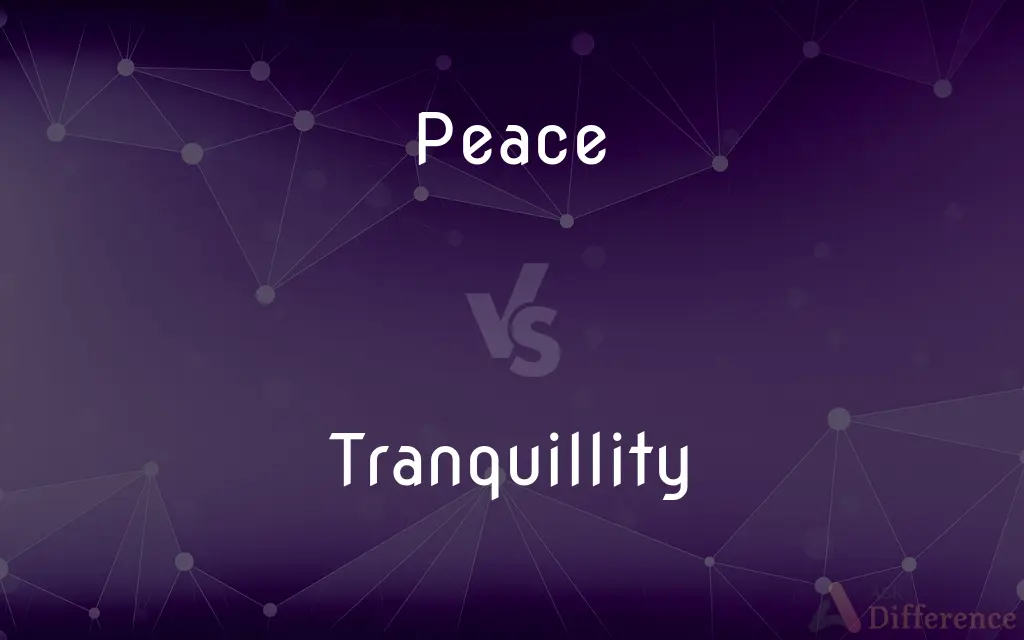Peace vs. Tranquillity — What's the Difference?
By Fiza Rafique & Maham Liaqat — Updated on April 2, 2024
Peace is a state of freedom from conflict or disturbance, often used in the context of social and political harmony, whereas tranquility refers to a state of calmness and quiet in a more personal or environmental context.

Difference Between Peace and Tranquillity
Table of Contents
ADVERTISEMENT
Key Differences
Peace is typically associated with the absence of war, conflict, or strife within a community, nation, or between countries. It implies a societal or global condition where entities coexist harmoniously without active disputes. Tranquility, on the other hand, denotes a more individual or localized sense of calmness and serenity, often free from anxiety or disturbance, and can apply to mental states, environments, or situations.
While peace often requires active efforts and agreements to maintain harmony among groups or nations, tranquility can be achieved through personal practices or by seeking environments that are naturally calm and serene. This distinction highlights the difference in scale and effort involved in attaining peace versus tranquility.
Peace can be measured by the absence of conflict and the presence of justice and equality, showcasing its social and political dimensions. Tranquility, however, is more subjective, varying greatly from person to person and situation to situation, often measured by personal feelings of calm and contentment.
The pursuit of peace often involves diplomacy, treaties, and sometimes interventions to resolve conflicts and foster understanding between conflicting parties. Tranquility might involve personal or community efforts to create or maintain a quiet and soothing environment, such as through meditation, nature conservation, or noise regulations.
In literature and art, peace is often depicted as an ideal state of the world or society, symbolizing harmony and the end of suffering. Tranquility, however, is frequently portrayed through natural scenes, quiet moments, or meditative practices, highlighting its association with personal or environmental calm.
ADVERTISEMENT
Comparison Chart
Definition
Absence of war and conflict; societal harmony.
State of calmness and quiet; personal or environmental serenity.
Scale
Societal, national, or international.
Individual, local, or environmental.
Effort Required
Diplomacy, treaties, interventions.
Personal practices, seeking natural calm environments.
Measurement
Measured by absence of conflict, justice, equality.
Subjective, based on personal feelings of calm.
Typical Context
Social, political.
Personal, environmental.
Depiction in Arts
Ideal state of the world/society, harmony.
Natural scenes, quiet moments, meditation.
Compare with Definitions
Peace
A state of societal harmony.
The community's efforts led to a lasting peace in the region.
Tranquillity
Personal state of calmness.
The tranquil garden became her escape from the chaos of the city.
Peace
Freedom from conflict or war.
The treaty brought peace between the two warring nations.
Tranquillity
Achieved through personal effort or natural setting.
Meditation brought him tranquility amidst stress.
Peace
Achieved through diplomacy and treaties.
Diplomats worked tirelessly to negotiate peace.
Tranquillity
Reflects a subjective feeling of peace.
Early mornings in the countryside are filled with tranquility.
Peace
Symbolizes global or societal ideal.
Nobel Peace Prizes are awarded to those contributing significantly to world peace.
Tranquillity
Quiet and serene environment.
The cabin by the lake offered tranquility away from urban noise.
Peace
Absence of disturbance in a social context.
The peace march advocated for non-violence and harmony.
Tranquillity
Often associated with nature and quiet moments.
The tranquility of the forest at dawn is unparalleled.
Peace
Peace is a concept of societal friendship and harmony in the absence of hostility and violence. In a social sense, peace is commonly used to mean a lack of conflict (such as war) and freedom from fear of violence between individuals or groups.
Tranquillity
Tranquillity (also spelled tranquility) is the quality or state of being tranquil; that is, calm, serene, and worry-free. The word tranquillity appears in numerous texts ranging from the religious writings of Buddhism, where the term passaddhi refers to tranquillity of the body, thoughts and consciousness on the path to enlightenment, to an assortment of policy and planning guidance documents, where interpretation of the word is typically linked to engagement with the natural environment....
Peace
The absence of war or other hostilities.
Tranquillity
The quality or state of being tranquil; calm
Passing cars are the only noise that disturbs the tranquillity of rural life
Peace
An agreement or a treaty to end hostilities
Negotiated the peace.
Tranquillity
The quality or state of being tranquil; serenity.
Peace
Freedom from quarrels and disagreement; harmonious relations
Roommates living in peace with each other.
Tranquillity
The state of being tranquil; peacefulness, the absence of disturbance or stress; serenity; calm.
Peace
Public security and order
Was arrested for disturbing the peace.
Tranquillity
The quality or state of being tranquil; calmness; composure.
Peace
Inner contentment; serenity
Peace of mind.
Tranquillity
An untroubled state; free from disturbances
Peace
Used as a greeting, a farewell, or a request for silence.
Tranquillity
A state of peace and quiet
Peace
A state of tranquility, quiet, and harmony; absence of violence. For instance, a state free from civil disturbance.
Our lounge strives to maintain an environment of peace for the comfort of our customers.
Tranquillity
A disposition free from stress or emotion
Peace
A state free of oppressive and unpleasant thoughts and emotions.
The safety equipment will give me some peace of mind.
Peace
Harmony in personal relations.
Peace
A state free of war, in particular war between different countries.
May there be peace in our time.
Peace
(archaic) Shut up!, silence!; be quiet, be silent.
Peace
(slang) Peace out; goodbye.
Peace
To make peace; to put at peace; to be at peace.
Peace
(slang) To peace out.
Peace
A state of quiet or tranquillity; freedom from disturbance or agitation; calm; repose
Peace
To make or become quiet; to be silent; to stop.
When the thunder would not peace at my bidding.
Peace
The state prevailing during the absence of war
Peace
Harmonious relations; freedom from disputes;
The roommates lived in peace together
Peace
The absence of mental stress or anxiety
Peace
The general security of public places;
He was arrested for disturbing the peace
Peace
A treaty to cease hostilities;
Peace came on November 11th
Common Curiosities
What is tranquility?
Tranquility refers to a state of calmness and quiet, whether in a personal, situational, or environmental context.
How is peace achieved?
Peace is typically achieved through diplomacy, negotiations, and sometimes interventions to resolve conflicts.
Can tranquility exist without peace?
Yes, one can experience personal tranquility even in the absence of societal peace, though external conflicts can affect one's inner calm.
How can one find tranquility?
Tranquility can be found through personal practices like meditation, or by being in calm and serene environments.
What is peace?
Peace is a state of freedom from conflict or war, often referring to societal or global harmony.
Does tranquility only refer to nature?
While closely associated with natural environments, tranquility can also describe calmness in personal mental states or quiet spaces.
Is tranquility a passive state?
While tranquility often involves a sense of passivity, achieving it can require active effort, such as engaging in practices that promote calm.
Is peace always a global concept?
While often used in a global context, peace can also refer to harmony within smaller communities or groups.
Can technology aid in achieving tranquility?
Technology, when used mindfully, can help create environments or tools conducive to tranquility, such as noise-canceling headphones or meditation apps.
What are common obstacles to achieving peace and tranquility?
Common obstacles include unresolved conflicts, societal inequalities, personal anxieties, and environmental disturbances.
Can efforts towards peace increase tranquility?
Yes, efforts towards societal or global peace can create environments that foster personal and environmental tranquility.
How do art and literature portray peace and tranquility?
Peace is often depicted as an ideal societal state, while tranquility is portrayed through serene landscapes and quiet moments.
What role does government play in peace?
Governments play a crucial role in establishing and maintaining peace through policies, diplomacy, and law enforcement.
How does tranquility affect health?
Experiencing tranquility can positively impact mental and physical health by reducing stress and improving well-being.
Can one contribute to peace?
Individuals can contribute to peace through actions that promote understanding, tolerance, and community service.
Share Your Discovery

Previous Comparison
Identify vs. Classify
Next Comparison
Mugging vs. JuggingAuthor Spotlight
Written by
Fiza RafiqueFiza Rafique is a skilled content writer at AskDifference.com, where she meticulously refines and enhances written pieces. Drawing from her vast editorial expertise, Fiza ensures clarity, accuracy, and precision in every article. Passionate about language, she continually seeks to elevate the quality of content for readers worldwide.
Co-written by
Maham Liaqat















































